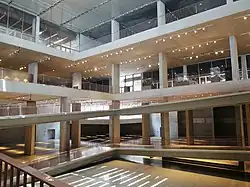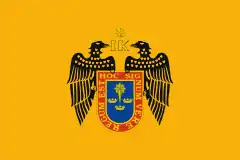National Museum of Peru
The National Museum of Peru is a national museum in Lurín District, Lima, Peru, located within the archaeological zone of Pachacamac. The museum will hold over a half million artifacts of the Pre-Columbian era and Inca Empire, ranging back to 5,000 BCE.[1] It opened in July 2021 as part of Peru's bicentennial celebrations and is capable of accepting 15,000 guests per day.[2][3]
Museo Nacional del Perú (MUNA) | |
 | |
.jpg.webp) Main façade of the museum. | |
| Location | Lurín District, Lima, Peru |
|---|---|
| Type | National museum |
| Collection size | 500,000 |
| Owner | Government of Peru |
| Website | muna |
History

Planning and construction
Ideas for a national museum were first proposed by José de San Martín in 1822 when he proposed a national museum, library and archive to be constructed during the Peruvian War of Independence.[4] The idea was promoted again nearly two centuries later by Minister of Culture Diana Álvarez Calderón during the administration of President Ollanta Humala in 2013.[5] Humala had initial plans for a museum in Peruvian Amazonia, though Álvarez Calderón urged him to dedicate a national museum to Peru first, with ideas of creating a National Museum of Peru.[5] In May 2014, bidding for the project's design was announced,[6] with architect Alexia León Ángel winning the competition.[2]
The plan involved filling the new museum with pieces from the Museo de la Nación – the former Ministry of Fisheries headquarters from 1970 – and the National Museum of Archaeology, Anthropology and History of Peru, which was outdated and did not have proper equipment to maintain the temperature and lighting of displays.[7] The process for safely transferring the items from other sites to the museum was anticipated to take about twenty years.[8] Another area for more contemporary objects was also planned to fill the 70,000 square metres (750,000 sq ft) of space.[7] By late-2017, planned areas for recreation and administration were removed to lower costs, with the seven-story, $125 million museum's area being set at 65,000 square metres (700,000 sq ft).[4][9]
During the government of Francisco Sagasti, the Ministry of Culture announced in November 2020 that the museum was destined to open in July 2021 for the celebration of Peru's two-hundredth anniversary of independence.[10]
Operation
In late July 2021, MUNA opened to the public with a limited display in four galleries.[4] One gallery featured information about the museum's background and construction while another highlighted how Peru's antiquities and culture were exploited by illicit trade.[4] MUNA is expected to be fully operational in 2024.[4]
See also
References
- "Museo Nacional de Arqueología del Perú se culminará a mediados del 2019 | LIMA". El Comercio (in Spanish). 2018-12-28. Retrieved 2020-11-24.
- "Presentan proyecto ganador de concurso de ideas para futuro Museo Nacional". Andina (in Spanish). Retrieved 2020-11-24.
- "Presidente Vizcarra anuncia compromiso del gobierno de entregar nuevo Museo Nacional del Perú". www.gob.pe (in Spanish). Retrieved 2020-11-24.
- Angeleti, Gabriella (13 September 2021). "Peru's heritage gets a new $125m home". The Art Newspaper. Retrieved 29 September 2021.
- "Diana Álvarez Calderón: entre ruinas y cultura viva | LUCES". El Comercio (in Spanish). 22 December 2013. Retrieved 24 November 2020.
- "Abrirán convocatoria para diseñar el Museo Nacional del Perú»". El Comercio. 29 May 2014.
- "Museo Nacional del Perú ya cuenta con diseño arquitectónico". La Republica. 24 July 2014. Archived from the original on 2014-12-14.
- "MUNA, un museo emblema para celebrar el bicentenario | FOTOS | LUCES". El Comercio (in Spanish). 2019-09-18. Retrieved 2020-11-24.
- "Lurín: construcción del Museo Nacional del Perú registra un 22% de avance | LIMA". El Comercio (in Spanish). 2017-08-10. Retrieved 2020-11-24.
- "Lurín: Museo Nacional del Perú será inaugurado en julio del 2021 | nnpp | LIMA". Peru21 (in Spanish). 2020-11-24. Retrieved 2020-11-24.
